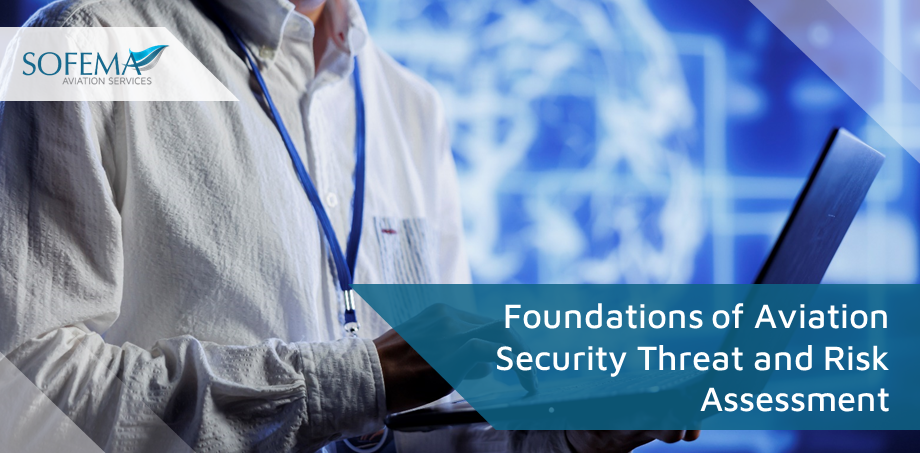Sofema Aviation Services (SAS) www.sassofia.com considers the role of Aviation Security as a pillar of the global aviation industry, ensuring the safety of passengers, crew, and assets.
The foundations of aviation security threat and risk assessment are rooted in structured methodologies that identify vulnerabilities, evaluate threats, and implement mitigating actions.
For entities operating within EASA and EU frameworks, compliance with specific regulations and best practices is critical.
The Regulatory Ecosystem Drivers include the following:
- Regulation (EC) No 300/2008 – This Regulation establishes common rules to protect civil aviation against acts of unlawful interference that jeopardize the security of civil aviation. It also provides the basis for a common interpretation of Annex 17 to the Chicago Convention on International Civil Aviation.
- Commission Implementing Regulation (EU) 2015/1998 – Commission Implementing Regulation (EU) 2015/1998 of 5 November 2015 laying down detailed measures for the implementation of the common basic standards on aviation security.
- ISO/IEC 27001 (Information Security Management) – Scope: Provides a framework for managing information security, relevant for aviation cybersecurity.
- ICAO Standards Adopted by the EU – Annex 17 – Aviation Security – Scope: Provides international standards and recommended practices for safeguarding civil aviation against acts of unlawful interference.
Aviation Security Threat & Risk Management Cycle
The Aviation Security Threat & Risk Management Cycle is a structured framework to manage security threats effectively, ensuring robust safety measures across the aviation sector.
- It begins with the capture phase, gathering intelligence from various sources such as surveillance systems, reports, and open-source intelligence.
- This data forms the foundation for threat identification, where risks are categorized, prioritized, and analyzed for credibility and potential impact.
- The assessment phase evaluates the likelihood and severity of threats using risk assessment models and scenario analysis, enabling informed decision-making.
- Once risks are understood, the response phase activates measures to mitigate or neutralize threats, such as implementing security protocols, deploying resources, or engaging emergency responses.
- Effective collaboration with law enforcement and regulatory bodies is often necessary.
- Communication plays a central role, ensuring stakeholders, passengers, and the public receive timely and accurate updates while preventing misinformation or panic.
- Finally, the monitoring phase evaluates the effectiveness of responses and ensures continuous vigilance through metrics and post-incident analysis, feeding insights back into the process for ongoing improvement.
Key Components of Aviation Security Threat and Risk Assessment
Threat Identification
Purpose: To recognize potential threats to aviation operations, including terrorism, cyber-attacks, insider threats, and unlawful interference.
Challenges & Best Practices:
- Dynamic and evolving threat landscape.
- Difficulty in obtaining accurate and actionable intelligence.
- Balancing over-preparation against practical and cost-effective solutions.
- Regularly consult intelligence reports and threat assessments from organizations like ICAO, EASA, and the EU Aviation Security Committee.
- Engage with local and regional authorities to understand specific threat dynamics.
Risk Assessment
Purpose: Evaluate the likelihood and impact of identified threats and prioritize resources accordingly.
Challenges & Best Practices:
- Variability in data availability and quality.
- Subjective biases in threat evaluation.
- Integration of cross-border and multi-stakeholder perspectives in assessments.
- Use standardized tools like ICAO’s Risk Context Statement or EU Risk Assessment Models.
- Foster a culture of data sharing among stakeholders, ensuring confidentiality and security.
Evolving Threat Landscape
- Cybersecurity threats are becoming as critical as physical threats, with risks of system breaches and data theft.
- Insider threats, where employees misuse access, are harder to detect and mitigate.
- Unpredictability in geopolitical events impacts threat levels.
Resource Allocation
- Balancing investments in security technologies with operational constraints.
- Limited financial and human resources in smaller organizations.
Inter-stakeholder Communication
- Difficulty in coordinating between airlines, airport operators, regulators, and law enforcement agencies.
- Variability in security culture and commitment among stakeholders.
Complexity of International Operations
- Harmonizing security practices across jurisdictions.
- Managing differing levels of security maturity among international partners.
Best Practices for Effective Aviation Security Threat and Risk Assessment
Holistic Approach
- Integrate security risk assessments into the Safety Management System (SMS) as per ICAO Annex 19 and EASA requirements.
- Consider the entire aviation ecosystem, including airports, airlines, cargo operators, and maintenance organizations.
Scenario-Based Training and Simulations
- Use real-world case studies to train personnel on identifying and mitigating threats.
- Simulate both physical and cyber-attack scenarios to test response readiness.
Risk-Based Security
- Allocate resources based on prioritized risks rather than applying uniform measures.
- Implement advanced screening and profiling techniques, ensuring compliance with data protection laws (e.g., GDPR).
Regular Audits and Updates
- Conduct periodic internal and external audits to ensure compliance and effectiveness.
- Update risk assessments frequently to account for new threats and regulatory changes.
Engagement with Stakeholders
- Develop strong partnerships with regulators, security agencies, and industry bodies.
- Facilitate regular communication and shared learning opportunities.
Next Steps
Follow this link to our Library to find & download related documents for Free.
Sofema Aviation Services and Sofema Online provides classroom, webinar and online training – please see the websites or email team@sassofia.com for comments of questions.
Tags:
Annex 17, security technologies, ICAO’s, open-source intelligence, surveillance systems, Risk Management Cycle, Aviation Security Threat, aviation cybersecurity, ISO/IEC 27001 (Information Security Management), Regulation (EU) 2015/1998, EASA, Regulation (EC) No 300/2008, safety of passengers, insider threats, unlawful interference, security threats, Cyber Attacks, SAS blogs, Aviation Security, Aviation Industry





